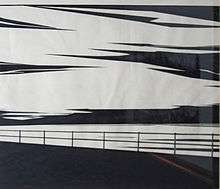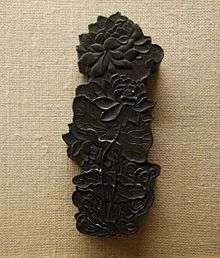India ink

India ink (British English: Indian Ink[1]; also Chinese ink) is a simple black or colored ink once widely used for writing and printing and now more commonly used for drawing and outlining, especially when inking comic books and comic strips. India ink is also used in medical applications.
Composition
Basic India ink is composed of a variety of fine soot, known as lampblack, combined with water to form a liquid. No binder material is necessary: the carbon molecules are in colloidal suspension and form a waterproof layer after drying. A binding agent such as gelatin or, more commonly, shellac may be added to make the ink more durable once dried. India ink is commonly sold in bottled form, as well as a solid form as an inkstick (most commonly, a stick), which must be ground and mixed with water before use. If a binder is used, India ink may be waterproof or non-waterproof.
History

The process of making India ink was known in China as early as the middle of the 3rd millennium BC, during Neolithic China.[2] India ink was first invented in China,[3][4][5] but the English term India(n) ink was coined due to the later trade with India.[3][4]
India ink has been in use in India since at least the 4th century BC, where it was called masi, an admixture of several substances.[6] Documents dating to the 3rd Century CE, written in Kharosthi with this ink have been unearthed in East Turkestan, Xinjiang, China.[7] The practice of writing with ink and a sharp-pointed needle in Tamil and other Dravidian languages was common practice since antiquity in South India, and so several ancient Buddhist and Jain scripts in India were compiled in ink.[8][9] In India, the carbon black from which India ink is formulated was obtained indigenously by burning bones, tar, pitch and other substances.[10]
The traditional Chinese method of making the ink was to grind a mixture of hide glue, carbon black, lampblack, and bone black pigment with a pestle and mortar, then pouring it into a ceramic dish where it could dry.[3] To use the dry mixture, a wet brush would be applied until it reliquified,[3] or more commonly in East Asian calligraphy, grind against an inkstone. The manufacture of India ink was well-established by the Cao Wei dynasty (220–265 AD).[11] Historically the ink used in China were in the form of ink sticks made of lampblack and animal glue.
The Chinese had used India ink derived from pine soot prior to the 11th century AD, when the polymath official Shen Kuo (1031–1095) of the mid Song Dynasty became troubled by deforestation (due to the demands of charcoal for the iron industry) and desired making ink from a source other than pine soot. He believed that petroleum (which the Chinese called 'rock oil') was produced inexhaustibly within the earth and so decided to make an ink from the soot of burning petroleum, which the later pharmacologist Li Shizhen (1518–1593) wrote was as lustrous as lacquer and was superior to pine soot ink.[12][13][14][15]
A common ingredient in India ink, called carbon black, has been used by many ancient historical cultures. For example, the ancient Egyptians and Greeks both had their own recipes for "carbon black". One Greek recipe, from 40 to 90 AD, was written, documented and still exists today.[16]
Artistic uses
- India ink is also used in commonly-used artist pens, such as Faber-Castell's fiber tipped Pitt pens.
- Many artists who use watercolor paint or other liquid mediums use waterproof India ink for their outlining because the ink does not bleed once it is dry.
- Some other artists use both black and colored India ink as their choice medium in place of watercolors. The ink is diluted with water to create a wash, and typically done so in a ceramic bowl. The ink is layered like watercolors, but once dry, the ink is waterproof and cannot be blended.
- Ink blotting is a form of art in which the artist places a blob of ink on special paper, then using a blower (a hair dryer will also work) blows the ink around the page, then sometimes will fold the paper in half to get a mirrored image ink blot.
- Some artists who favor using monochromatic color palettes (one color but in different shades), especially grey tones, often use India ink for its ability to be mixed in water for lighter colors as well as its ability to layer colors without bleeding.
- Tattoo artists use India ink as a black ink for tattoos.[17]
Non-art use
- Hanetsuki (羽根突き, 羽子突き) is a Japanese traditional game, similar to badminton, played by girls at the New Year with a rectangular wooden paddle called a hagoita and a brightly colored shuttlecock. The shuttlecock must be kept in the air as long as possible. Girls who fail to hit the shuttlecock get marked on the face with India ink.[18]
- In pathology laboratories, India ink is applied to surgically removed tissue specimens to maintain orientation and indicate tumor resection margins. The painted tissue is sprayed with acetic acid, which acts as a mordant, "fixing" the ink so it doesn't track. This ink is used because it survives tissue processing, during which tissue samples are bathed in alcohol and xylene and then embedded in paraffin wax. When viewed under the microscope, the ink at the tissue edge informs the pathologist of the surgical resection margin or other point of interest.
- Microbiologists use India ink to stain a slide containing micro-organisms. The background is stained while the organisms remain clear. This is called a negative stain. India ink, along with other stains, can be used to determine if a cell has a gelatinous capsule.[19] A common application of this procedure in the clinical microbiology laboratory is to confirm the morphology of the encapsulated yeast Cryptococcus spp. which cause cryptococcal meningitis.
- Medical researchers use India ink to visualize blood vessels when viewed under a microscope.
- Scientists performing Western blotting may use India ink to visualized proteins separated by electrophoresis and transferred to a nitrocellulose or PVDF membrane.
- Model railroaders use a mixture of India ink and isopropyl alcohol as a wood stain, graying wood to appear aged and to bring out detail.
- India ink is used diluted as an ultra-fine polishing medium for making precise optical surfaces on metals.[20]
- In ophthalmology, it was and still is used to some extent in corneal tattooing.
- Once dry, its conductive properties make it useful for electrical connections to difficult substrates, such as glass. Although relatively low in conductivity, surfaces can be made suitable for electroplating, low-frequency shielding, or for creating large conductive geometries for high voltage apparatuses. A piece of paper impregnated with India ink serves as a grid leak resistor in some tube radio circuits.
- Zoological museum specimens were often tagged in India ink, either directly or on a piece of tracing paper stored along the specimen, because of its durability even when submerged in preservative fluids.
See also
Notes
- ↑ "Oxford English Dictionary". www.oed.com/. Oxford University Press. Retrieved 25 August 2017.
- ↑ Woods & Woods, 51–52.
- 1 2 3 4 Gottsegen, page 30.
- 1 2 Smith, page 23.
- ↑ Avery, page 138.
- ↑ Banerji, page 673
- ↑ Sircar, page 206
- ↑ Sircar, page 62
- ↑ Sircar, page 67
- ↑ "India ink" in Encyclopædia Britannica. 2008 Encyclopædia Britannica Inc.
- ↑ Sung, Sun & Sun, pages 286–288.
- ↑ Sivin, III, page 24.
- ↑ Menzies, page 24.
- ↑ Needham, Volume 5, Part 7, pages 75–76.
- ↑ Deng, page 36.
- ↑ "Spotlight on Indian Ink". Winsor & Newton. November 10, 2013.
- ↑ "Spotlight on Indian Ink". www.winsornewton.com. Retrieved 2017-08-20.
- ↑ "The Hanetsuki game". Archived from the original on 9 March 2013.
- ↑ Woeste and Demchick, Volume 57, Part 6, pages 1858–1859
- ↑ NASA Technical Brief
References
- Avery, John Scales (2012). Information Theory and Evolution (2nd ed.). Singapore: World Scientific. p. 138. ISBN 9789814401241.
- Banerji, Sures Chandra (1989). A Companion to Sanskrit Literature. Motilal Banarsidass. ISBN 81-208-0063-X.
- Deng, Yinke (2005). Ancient Chinese Inventions. Translated by Wang Pingxing. Beijing: China Intercontinental Press. ISBN 7-5085-0837-8.
- Gottsegen, Mark D. (2006). The Painter's Handbook: A Complete Reference. New York: Watson-Guptill Publications. ISBN 0-8230-3496-8.
- Menzies, Nicholas K. (1994). Forest and Land Management in Imperial China. New York: St. Martin's Press, Inc. ISBN 0-312-10254-2.
- Needham, Joseph (1986). Science and Civilization in China: Volume 5, Chemistry and Chemical Technology, Part 7, Military Technology; the Gunpowder Epic. Taipei: Caves Books, Ltd.
- Sircar, D.C. (1996). Indian epigraphy. Motilal Banarsidass. ISBN 81-208-1166-6.
- Sivin, Nathan (1995). Science in Ancient China: Researches and Reflections. Brookfield, Vermont: Variorum, Ashgate Publishing.
- Smith, Joseph A. (1992). The Pen and Ink Book: Materials and Techniques for Today's Artist. New York: Watson-Guptill Publications. ISBN 0-8230-3986-2.
- Sung, Ying-hsing; Sun, E-tu Zen; Sun, Shiou-chuan (1997). Chinese Technology in the Seventeenth Century: T'ien-kung K'ai-wu. Mineola: Dover Publications. ISBN 0-486-29593-1.
- Woods, Michael; Woods, Mary (2000). Ancient Communication: Form Grunts to Graffiti. Minneapolis: Runestone Press; an imprint of Lerner Publishing Group.....
- Woeste S.; Demchick, P. (1991). Appl Environ Microbiol. 57(6): 1858-1859 ASM.org
- History of Tattoos, The Tattoo Collection, No Date Published
External links
